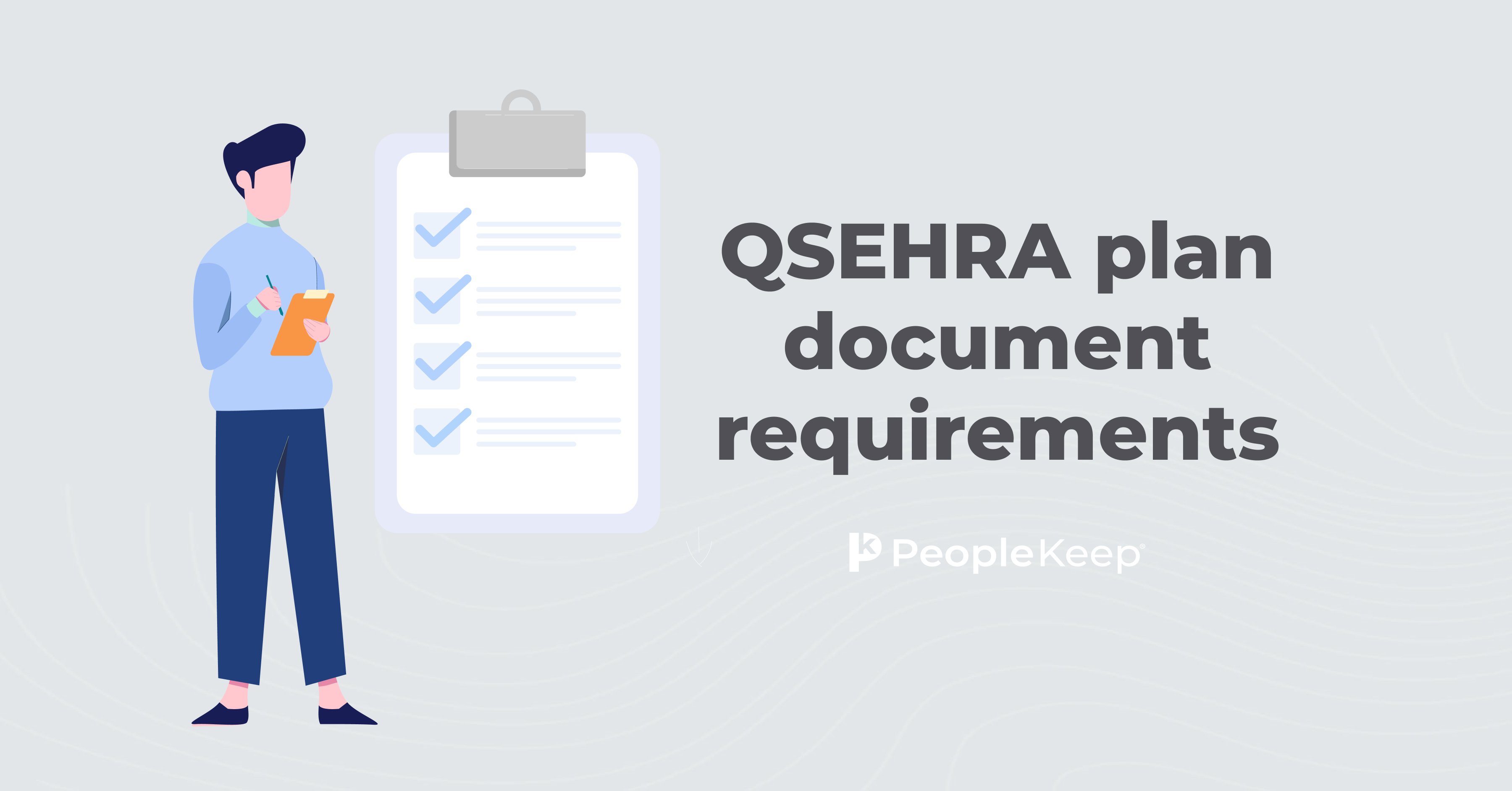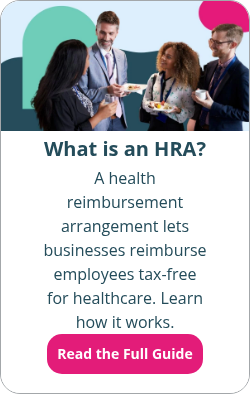HRA plan documents: What are the requirements?
By Holly Bengfort on February 29, 2024 at 7:14 AM
When considering health benefit options, many employers turn to health reimbursement arrangements (HRAs) as a cost-effective and flexible alternative to traditional group health insurance. HRAs allow employers to reimburse employees for individual health insurance coverage rather than purchasing a the same group policy for all employees.
Like many employee benefit programs, HRAs have certain requirements, such as plan documents, that must be met to maintain compliance. In this article, we'll explore the requirements for HRA plan documents.
Takeaways from this blog post:
- An HRA is an IRS-approved, employer-funded health benefit that allows employers to reimburse employees tax-free for eligible medical expenses, including individual health insurance premiums.
- HRA plan documents must include detailed information such as plan administrator, benefit descriptions, eligibility criteria, and more. Noncompliance can result in costly fines.
- Employers can use HRA administration tools like PeopleKeep to easily create and manage compliant HRA plan documents.
What is an HRA?
A health reimbursement arrangement (HRA) is an IRS-approved, employer-funded health benefit. With an HRA, employers can reimburse employees tax-free for eligible medical expenses. Depending on the type of HRA, this can include their individual health insurance premiums.
Here's a quick breakdown of how an HRA works:
- Employers decide how much tax-free money they want to offer to employees each month.
- Employees make healthcare purchases using their own money.
- Employees submit proof of their medical expenses for reimbursement.
- Employers verify the eligible health expense and reimburse the employee up to their set allowance amount.
There are several types of HRAs available. There's one to fit every organization's unique needs.
The three most popular HRAs include:
- The qualified small employer HRA (QSEHRA): The QSEHRA is designed for small businesses and nonprofits with fewer than 50 full-time equivalent employees (FTEs). It provides tax-free reimbursement for all W-2 employees, whether they have an individual policy or coverage through a parent or spouse, as long as they have minimum essential coverage (MEC).
- The individual coverage HRA (ICHRA): The ICHRA works for businesses of all sizes. However, employees must have individual health insurance coverage to participate in the benefit. Employees can submit their monthly premiums and other qualifying medical expenses for reimbursement.
- The group coverage HRA (GCHRA): The GCHRA, also known as an integrated HRA, works with an employer-sponsored group health plan. It helps to cover out-of-pocket expenses that the group health insurance plan doesn’t fully pay for.
What are the plan rules for an HRA?
The Internal Revenue Service (IRS) defines the rules and guidelines for an HRA in IRS Notice 2002-451.
Under these rules:
- Only employers can contribute to an HRA. An employer can't fund it through employee salary deductions.
- An HRA may only reimburse employees during their effective dates in the HRA plan.
- An HRA can reimburse for eligible medical expenses and health insurance premium amounts, as defined in IRC Section 213(d)(1)(D).
- Each eligible medical expense requires substantiation.
- Employers generally exclude reimbursements from the employee's gross income under Internal Revenue Code Sections 106 and 105.
What are the plan requirements for an HRA?
To offer an HRA, your organization must comply with the following laws:
- IRS compliance: The IRS requires employers to set up a formal HRA to receive tax-free reimbursements.
- Federal compliance: A company must have measures and safeguards in place to meet HIPAA and ERISA regulations.
- Health Insurance Portability and Accountability Act of 1996 (HIPPA): An HRA is a self-funded health plan governed by the HIPAA Privacy Rules. To administer an HRA, the entity processing the claims receives protected health information (PHI), which HIPAA protects. Employers that don't comply with HIPPA privacy laws are subject to civil penalties of up to $100 per violation.
- Employee Retirement Income Security Act of 1974 (ERISA): The U.S. federal government has specific regulations that employers must comply with to reimburse employees for individual health insurance premiums without triggering ERISA plan status for the individual health insurance policies. One such requirement is a plan document.
- Affordable Care Act (ACA): The ACA sets additional requirements for HRAs, including how employers present benefit information to employees, which forms are necessary for reporting forms, and how plans must be designed. The HRA plan must have the appropriate documents, data, and plan settings in place to be ACA-compliant.
What are the plan document requirements for an HRA?
Formal HRA plan documents should contain each of the following:
- Name of the HRA plan document administrator
- Designation of any named fiduciaries other than the HRA plan administrator under the claims procedure for deciding benefit appeals and their responsibilities
- A description of the HRA benefits provided
- The standard of review for HRA benefit decisions
- Eligibility criteria (e.g., classes of employees and waiting periods for new hires)
- The effective date of participation (e.g., the next day or first of the month following satisfaction of the HRA eligibility waiting period)
- Amount the HRA participant must pay toward the cost of HRA coverage (typically $0, but some employers set up HRAs with deductibles for out-of-pocket expenses)
- HRA plan sponsor's amendment and termination rights and procedures, and what happens to HRA plan assets, if any, in the event of HRA plan termination
- Rules restricting and regulating the use of protected health information (PHI) if the plan sponsor receives PHI. You’ll also need to name any HIPAA privacy officers
- Coordination of benefits provisions
- Procedures for allocating and designating administrative duties to an HRA third-party administrator (TPA) or committee
- How you will fund the HRA plan
- Information regarding the Consolidated Omnibus Budget Reconciliation Act of 1985 (COBRA), HIPAA, and other federal mandates
Want to see tips specific to stand-alone HRAs like the QSEHRA or ICHRA? See our plan document articles below:
Where can I get HRA plan documents?
You can access plan documents from various online resources, software, or trusted advisors. Some small employers hire attorneys or use other legal services to create formal plan documents, which can be costly. Pre-written plan documents are also expensive, and once purchased, you can't easily modify them if your organization wants to change the benefit in a new benefit year.
Drafting HRA plan documents on your own can be risky. Noncompliance with ERISA requirements can result in tax consequences, including fines of up to $100 per day per employee.
If you want to avoid unnecessary costs and associated risks, you should utilize an HRA administration tool like PeopleKeep. Our services include custom HRA plan documents, free plan amendments, and simple online benefits administration. Our team of experts will even review your employees’ reimbursement requests and documentation so you can save time and avoid any HIPAA violations.
Conclusion
Creating comprehensive health reimbursement arrangement (HRA) plan documents is necessary for employers to establish a clear framework for their health benefits and ensure compliance with applicable laws and regulations.
Consulting with legal and benefits professionals can help employers navigate the complexities of HRA requirements and develop plan documents that meet the needs of both the employer and employees.
Let PeopleKeep's personalized benefits administration software handle the hard work for you. You can set up and manage your HRA in just minutes each month.
This blog post was originally published on December 3, 2018. It was last updated on February 29, 2024.
Check out more resources
See these related articles

HRA Plan Requirements
An overview of HRA Plan Requirements including HRA rules, HRA Plan Documents and setting up an HRA plan.

QSEHRA plan document requirements
In this post, we’ll discuss the requirements associated with QSEHRA plan documents and what information those documents should include.

Section 105 Plan Document Requirements
Section 105 Plan Document Requirements. What the Section 105 Plan Documents are required to include, and why you need plan documents for Section 105 Plans.



